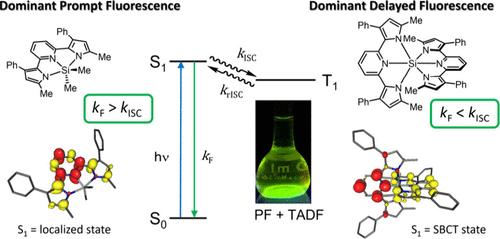Unveiling the Effect of Symmetry-Breaking Charge Transfer on Intersystem Crossing in Group 14 TADF Emitters
IF 4.7
2区 化学
Q1 CHEMISTRY, INORGANIC & NUCLEAR
引用次数: 0
Abstract
Three organotetrel compounds (MePDPPh)EMe2 (E = Si, Ge, Sn) have been synthesized by the reaction of 2,6-bis(5-methyl-3-phenyl-1H-pyrrol-2-yl)pyridine (H2MePDPPh) with EMe2Cl2. All three molecules show photoluminescence (ΦPL = 0.66–0.75) through a combination of prompt fluorescence (PF) and thermally activated delayed fluorescence (TADF). Increased contributions from TADF for the heavier tetrel species imply more facile intersystem crossing due to intramolecular heavy-atom effects. Computational studies confirm that the lowest-energy singlet and triplet excited states in (MePDPPh)EMe2 result from localized transitions within the [MePDPPh]2– ligand, with only minor contributions from the tetrel atom. In contrast, the previously reported bis-PDP tetrel compounds E(MePDPPh)2 (E = Si, Ge, Sn), for which the lowest-energy singlet excited state was computed to be a symmetry-broken ligand-to-ligand charge transfer state, exhibit increased contributions from TADF compared to (MePDPPh)EMe2. Kinetic analysis of the TADF emission for all six compounds supports increased intersystem crossing and reverse intersystem crossing rate constants (kISC/rISC) and quantum yields (ΦISC/rISC) for E(MePDPPh)2 compared to (MePDPPh)EMe2. These results highlight the importance of symmetry-breaking charge transfer in facilitating intersystem crossing and provide a blueprint for the design of molecules that can access long-lived triplet states in the absence of heavy elements.

揭示14族TADF发射体中对称破缺电荷转移对系统间交叉的影响
以2,6-二(5-甲基-3-苯基- 1h -吡咯-2-基)吡啶(H2MePDPPh)与EMe2Cl2反应合成了三个有机四萜类化合物(MePDPPh)EMe2 (E = Si, Ge, Sn)。这三种分子通过提示荧光(PF)和热激活延迟荧光(TADF)的结合表现出光致发光(ΦPL = 0.66-0.75)。对于较重的四鳖物种,TADF的贡献增加意味着由于分子内重原子效应,更容易进行系统间杂交。计算研究证实,(MePDPPh)EMe2中最低能量的单重态和三重态激发态是由[MePDPPh]2 -配体内部的局域跃迁引起的,只有四元原子的少量贡献。相比之下,先前报道的双pdp四萜化合物E(MePDPPh)2 (E = Si, Ge, Sn),其最低能量单线态激发态被计算为配体到配体的对称破缺电荷转移态,与(MePDPPh)EMe2相比,TADF的贡献增加。六种化合物的TADF发射动力学分析表明,与(MePDPPh)EMe2相比,E(MePDPPh)2的系统间交叉和反向系统间交叉速率常数(kISC/rISC)和量子产率(ΦISC/rISC)均有所增加。这些结果强调了对称破缺电荷转移在促进系统间交叉中的重要性,并为在没有重元素的情况下设计能够进入长寿命三重态的分子提供了蓝图。
本文章由计算机程序翻译,如有差异,请以英文原文为准。
求助全文
约1分钟内获得全文
求助全文
来源期刊

Inorganic Chemistry
化学-无机化学与核化学
CiteScore
7.60
自引率
13.00%
发文量
1960
审稿时长
1.9 months
期刊介绍:
Inorganic Chemistry publishes fundamental studies in all phases of inorganic chemistry. Coverage includes experimental and theoretical reports on quantitative studies of structure and thermodynamics, kinetics, mechanisms of inorganic reactions, bioinorganic chemistry, and relevant aspects of organometallic chemistry, solid-state phenomena, and chemical bonding theory. Emphasis is placed on the synthesis, structure, thermodynamics, reactivity, spectroscopy, and bonding properties of significant new and known compounds.
 求助内容:
求助内容: 应助结果提醒方式:
应助结果提醒方式:


